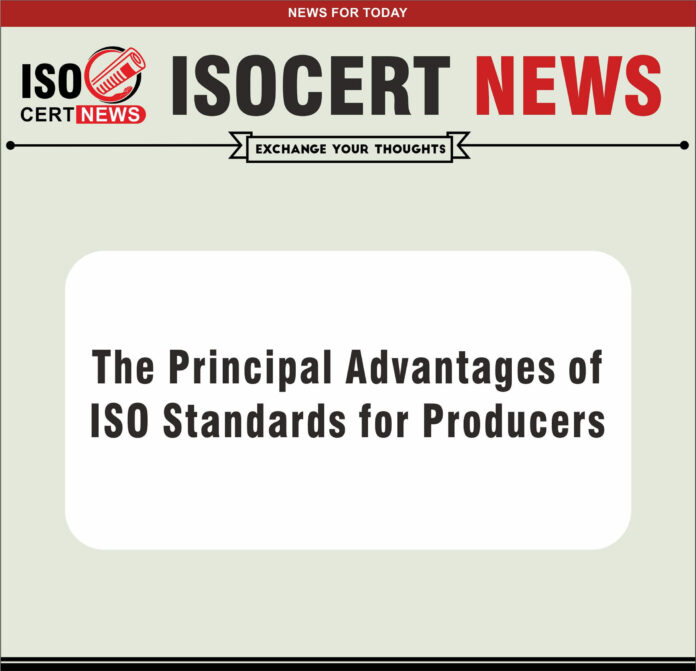Manufacturers may control risks, promote continuous development, and obtain a competitive advantage by putting these guidelines into practice.
ISO standards form a basis for companies to run smoothly, provide products of high quality, and be in line with the legislative requirements. Their benefits go beyond one region’s boundaries.
ISO standards including ISO 9001, are directly focused on quality management systems. Through implementing these standards, manufacturers can develop standardized quality control processes, keep the products/services deliveries uniform to the consumer, and improve customer satisfaction. ISO 9001 stresses the continuous improvement, risk management and customer focus principles, which help companies to deliver higher levels of quality assurance and satisfy the needs of their customers.
Competitive Advantages
Adhering to these standards helps organizations assure customers that they are focused on customer satisfaction, says Deb Iafrate, executive vice president of sales and marketing, at Eagle Group USA. “The 14001 & 45001 standards not only [enhance employee investment] but can provide customer satisfaction by [indicating] that major disruptions are less likely,” Iafrate says.
Similarly, Robert Katz, president, of Florida Standards Lab, says ISO accreditation serves as a great marketing tool.
Achieving certification to ISO standards can offer many benefits to organizations; however, the degree to which those benefits are realized can vary greatly depending on a variety of factors, says David English, group marketing director, Orion Registrar.
First, “primarily, the ISO certification is there to show that an organization meets internationally recognized standards in different areas,” English points out. “While doing so it gives evidence to stakeholders that it is a credible and serious producer or partner.” As a consequence, being able to present a third-party validation of the organization’s capability to meet the criterion of the standard can give the business a competitive edge, or more often, access to opportunities that are only open to enterprises that have the needed certification.
Complying with these requirements also results in increased operations efficiency. ISO standards define the standards for streamlining and optimizing the operational processes in manufacturing companies. Through the application of ISO 14001 (Environmental Management System) or ISO 50001 (Energy Management System), companies will be able to manage resources, minimize waste, and decrease their environmental impact. They not only enhance sustainable practices but also result in cost and time savings, operational efficiency as well as regulatory compliance.
Expanded Market Access
ISO certifications are a globally recognized means of proof of quality and conformity. Manufacturing institutions that are certified with ISO accreditations (ISO 9001 or ISO 13485, which touches on Medical Devices), demonstrate their focus on adhering to international standards. These certificates are not only reliable in the eyes of customers, partners, and suppliers but also they serve as the best remedy for opening new markets by confirming to them the organization’s expectations to such standards.
Increased Customer Confidence
The ISO standards build confidence because the manufacturers are disciplined to follow the same standards, customers’ needs are considered, and the products they deliver are reliable. ISO 27001 (Information Security Management System) and ISO 22301 (Business Continuity Management System) deal with data security and resilience, thus, enforcing client confidence in terms of sensitive information and ensuring smooth and uninterrupted business operations.
Risk Mitigation
ISO standards offer a risk assessment framework that manufacturing firms use to determine, assess, and manage their risks. The implementations of ISO 31000 (Risk Management) and ISO 45001 (Occupational Health and Safety Management System) are meant to help organizations devise systematic approaches for managing risks that may come as a result of workplace safety, occupational hazards, as well as business interruptions. The standards protect the manufacturers’ employees, assets, and reputation from large penalties, thus reducing the risk of incurring fines.
Continuous Improvement Culture
ISO standards enable an atmosphere of improvement by promoting the Plan-Do-Check-Act (PDCA) cycle. Organizations that follow ISO standards are prompted to evaluate their processes periodically, measure performance and implement corrective solutions whenever needed. This cyclical approach encourages continuous improvement, innovation, and striving for excellence in manufacturing firms.
How Standards Have Shifted
Yet, satisfactory numbers of ISO standards have proven to be sustainable over the years, IATF 16949 standard stands out as the toughest to get and has been subjected to yearly updates according to Iafrate.
As most ISO standards have to adapt to the market and other environmental conditions, Christopher M.Morrell, Vice President and General Manager, NSAI, says.
With changes in these requirements, organizational policies also need more system and process controls to approve compliance.
Another example is about medical device-notified bodies where they have been seeing dramatic standard evolutions in recent history mainly due to the complete reshuffling of EU Legislation in addition to the implementation of the Medical Device Single Audit Programme (MDSAP) which encompasses multiple countries’ requirements.
English cites the recent release of ISO 27001:2022, on the other hand, which indicates the changing cyber security needs that occur at a fast rate.
“When these new versions of a standard are released, organizations are given a grace period to make the transition to the new requirements,” English says. “For example, clients looking to be certified to ISO 27001: NCAA student-athletes have until October of 2025 to take this advantage.
Certainly, not all certifications are of equal value, continues English.
‘It is somewhat odd that it is not illegal to issue an ISO certificate, indeed companies can even issue their own. However, the certificates issued only by an accredited certification body are recognized as part of the Multi-lateral Framework Agreement of the International Accreditation Forum, which ensures that certificates will be accepted, worldwide. ANAB and UKAS are examples of this type of accreditation authority.
ISO standards are of utmost importance to manufacturers because of the multiplicity of benefits they bring. From improving quality management and operational efficiency to expanding market access and improving customer confidence, ISO standards provide a roadmap for organizations to move to excellence. Through the application of these standards, manufacturing companies can deal with risk, achieve continuous improvement, and gain a competitive advantage in the world market. Adopting ISO standards is a strategic measure that opens the way to long-term success and growth in a sustainable way.
SOURCE:- https://www.qualitymag.com/articles/97509-the-essential-benefits-of-iso-standards-for-manufacturers










